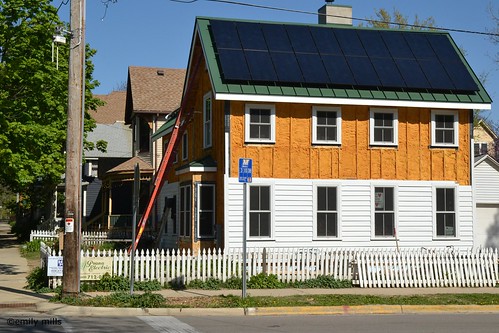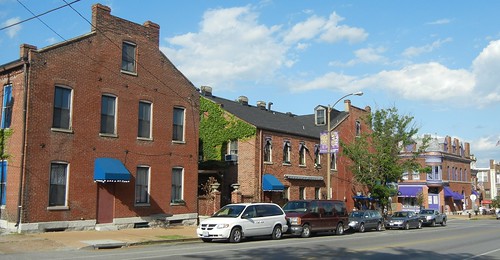by Michael R. Allen
This afternoon Cultural Resources Office Director Betsy Bradley will recommend that the Preservation Board adopt new standards governing solar collectors installed on City Landmarks and Sites and on buildings within Local Historic Districts. The board’s approval will allow the office to put forth new standards for public comment and then adopt a final version as official city policy. Today’s action could put St. Louis ahead of many other cities with historic districts. Nationwide, the preservation community is debating how to fix local ordinances written before solar panels were widely being installed. Although historic preservation and environmental laws are often compatible — and while historic preservation laws are environmental laws — recently there have been conflicts between new energy policies and practices and old approaches within historic preservation.

Locally, there has been at least one recent case in which the owner of a building within a local historic district initially faced denial by CRO of a permit to install street-facing solar panels, but won a new hearing and later approval from the Preservation Board. Four months later, CRO Director Bradley and her staff are recommending a two-track policy that seems to allow for reasonable judgment without compromising the integrity of the city’s local historic preservation laws. The two different tracks of review are:
1. No Visibility Required: An approach that requires solar panels to not be visible from the public areas of a historic district.
2. Visual Compatibility Required: An approach that allows some visibility of solar panels from public areas of a historic district while maintaining the character of the historic building and district.
CRO proposes that the “no visibility required” review standard be applied to City Landmarks and Sites as well as within districts that have that approach specified in their adopted design standards. Thus, CRO will make sure that all resources significant enough to be individually protected under the city’s preservation ordinance will never have their visible roofs marred by installation of panels. Districts with strict standards will be reviewed strictly.

The “visual compatibility required” standard will be used in the other instances, when local historic district standards allow. The standard will permit some visibility of solar collectors, as with those now installed on the Bastille bar’s street-facing roof slope in the Soulard Local Historic District (more about that matter here). The new policy allows CRO staff to help property owners accomplish energy efficiency without compromising overall district integrity. Sometimes, the only logical place to put solar panels may be a street-facing roof, or a roof partially visible for the sidewalk. CRO will have the authority to grant installation within its staff’s professional, reasonable judgment.
When all else might fail, the proposed standards state: “The Preservation Board may determine that when a property owner cannot meet the applicable Standards, it may be appropriate to approve the application when all efforts have been made to minimize the visual presence of the installation.” This sentence will alleviate any impasse review situations. As with the other provisions of the proposed policy, it is smart and consistent with the city’s laws protecting our historic built environment. A few months ago, with the case of the Bastille solar panels, there was some public sentiment that the city’s preservation laws were getting in the way of smart green technology. In the Preservation Board consents, the official policy will make sure that won’t be the case again.
Bradley and her staff are to be commended for a swift and smart response to the evident flaws in existing ordinances. City government rarely works so fast. Now, of course, neighborhoods need to respond by updating their local historic district ordinances. Residents would adopt either of the two review standards outlined above — meaning that they could enjoy wider rights to install solar panels if they so choose.
(The National Park Service has posted its recommendations for solar panel installation on historic buildings, including several examples that meet the Secretary of the Interior’s Standards for Rehabilitation, here. Solar panels and compliance with those standards — used in historic tax credit projects — is a separate subject.)

3 replies on “New Solar Panel Standards Proposed for City Historic Districts and Sites”
I am also happy that at least some city officials including Bradley and her staff are looking out for the welfare of the cities and their people instead of mindlessly and endlessly applying regulations that may not fit. No one wants a garish installation of solar panels in a historic district, including those who support the idea of energy efficiency.
To me the big question is when the urban planning structure of historic districts (Soulard, Lafayette Square) will be utilized in the rest of the city?
Transit commercial and human activity clearly worked differently in neighborhoods like Soulard and Lafayette Square compared to various suburbs in regional St. Louis.
There seems to be a general commitment to replicate the walk ability of historic neighborhoods. But where is the duplication of the transit aspects? If preservation is to succeed it must contribute its most valuable asset, energy efficiency into city planning. And who knows?, at this point solar panels may be a community necessity.
[…] How Does That Work You May Have Seen All The Publicity About Free Solar Installations Across The Uk!New Solar Panel Standards Proposed for City Historic Districts and Sites // IE Evitar seleccion de texto document.onselectstart=function(){ if […]
[WORDPRESS HASHCASH] The comment’s server IP (184.172.173.62) doesn’t match the comment’s URL host IP (184.172.183.131) and so is spam.
Solar panels are very easy to set up and are entirely safe for birds and bats. To even better the credentials of solar power and make it an attractive option for utility companies around the world, consultancy and certification firm DNV has come up with SUNdy – floating arrays of solar panels.